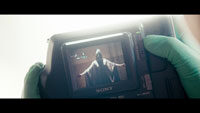***/**** Image A Sound A- Extras B+
directed by Errol Morris
by Bryant Frazer There's a tension in Errol Morris's Standard Operating Procedure between the subject matter–the torture and humiliation of inmates at the Abu Ghraib prison outside Baghdad during the U.S. occupation of Iraq–and what Morris is really up to. Anyone who's read his excellent "Zoom" blog for THE NEW YORK TIMES, including his brilliant, three-part consideration of the pedigree of two different photographs taken by Roger Fenton during the Crimean War, knows that the director is concerned lately with the methodical, emotionless investigation of the circumstances surrounding a picture's taking. He wants to know what a photo conceals in addition to what it reveals–what's happening outside its spatial frame? Its temporal boundaries?
|
That's the tack he takes in Standard Operating Procedure, which documents the filmmaker's analytical, almost cerebral approach to some of the most emotionally-charged images of modern history. When Morris gazes at the notorious snapshot of a naked Iraqi being held on a leash by U.S. Army Specialist Lynndie England, his eyes go to the edge of the frame, where one of England's friends has been (deliberately?) cropped out of some reproductions. Indeed, when he shows us a photograph, he underscores its status as evidence by centring the whole image in the middle of the screen instead of enlarging it to fill the space or panning across, Ken Burns-style. This film wants to know what's not seen in these images, and that's where the title comes from. These photos depict "standard operating procedure" inside Abu Ghraib–they're not aberrations from the norm, but evidence of the norm at that time in that facility. And the more culpable criminals, Morris argues, are not the soldiers in front of the camera, who are mere scapegoats, but rather their superiors, and their superiors' superiors, who authorized the routine humiliation of Iraqi prisoners in the first place.
Morris's methodology remains as impressive as ever, and he utilizes extensive videotaped interviews with soldiers–several of whom appear in those disturbing photos–as well as military investigators and private contractors. He jazzes up his technique with snazzy graphic design that visualizes, for example, the procedure of poring over the metadata attached to digital snapshots (metadata is just a fancy word for information about the pictures that's automatically attached, in camera, to the original picture files) to reconstruct a timeline and thus gain a broader understanding of the events being depicted.
He also resorts to his trademark re-enactments, which recreate some of the moments inside Abu Ghraib to which nobody's digital cameras were privy. They're ferocious and occasionally gorgeous pieces of cinematography, shot with film and high-speed digital cameras by ace DP Robert Richardson, yet they're oddly tone-deaf: the reason many viewers have objected to them here is that, in the context of the incredibly disturbing images this story is built from, such glossy Hollywood-style tableaux feel like an aggressive trivialization of real events, as well as a transgression against the deep emotional resonance of depictions of real torture and humiliation.
Nor does Morris's relative single-mindedness, generally a virtue in filmmaking, necessarily work in his favour. True, there was a Herculean task in the material: Morris says he had to funnel 1.5 million words of interview transcripts, tens of thousands of document pages, and more than 1000 photographs into the material found here. But Alex Gibney's powerful documentary Taxi to the Dark Side beat him to the punch, telling a wider-ranging and more complete story about the politics of wartime torture that comes to a similar conclusion about culpability–placing these atrocities squarely on the shoulders of Dick Cheney and Donald Rumsfeld rather than blaming low-ranking soldiers–without remaining so emotionally remote. It's true that Morris's film is more rigorous, but Gibney's feels more humane. In this context, that's a decided advantage.
| Click for hi-res BD captures |
 |
 |
 |
 |
THE BLU-RAY DISC
The Blu-ray Disc from Sony Pictures Classics is a fairly exhaustive piece of work. First, let it be said that the 1080p transfer, letterboxed to 2.40:1 inside the 16×9 frame, looks fantastic. The HDCAM interview segments (shot by the film's co-cinematographer, Robert Chappell) have a chilly visual quality that makes some of the subjects look almost ghoulish on camera, with strange, sunken faces, and the dramatic reconstructions have a disconcertingly high-end gloss, whether we're looking close-up at the bared teeth of a slobbering attack dog or at an overhead shower with highlights on the water streaming down in such a way as to resemble fireworks. The VFX segments showing, for instance, how Morris and his cohorts reconstructed pictorial timelines from multiple digital cameras, are especially dazzling in HiDef, as is the Kyle Cooper-designed credits sequence. An accompanying 5.1 Dolby TrueHD track is robust–the sound effects and, moreover, Danny Elfman's musical score (apparently channelling erstwhile Morris collaborator Philip Glass) aren't exactly directional, but they fill out the surround field nicely.
Equally importantly, the supplementary material–generously subtitled in Portuguese, Spanish, Chinese, Thai, Korean, and German–actually helps Morris complete his argument. For example, one of my complaints about Standard Operating Procedure itself was that Morris was somewhat uncritical when it came to his interview subjects. To wit, Specialist Sabrina Harman defends her cheesy grin and thumbs-up sign in several of the photographs by claiming she never knows what to do in photographs, so her apparently callous behaviour just came naturally. In a Q&A from the film's L.A. premiere (presented in HD, it runs 11 minutes), Morris acknowledges criticism of her demeanour, but claims that it doesn't matter in the face of the crimes that are being committed–in fact, he says, focusing on Harman's behaviour in the photographs only diverts attention from the real story they tell.
A press conference from the Berlin Film Festival in February, 2008 (32 mins., SD only) finds Morris along with producer Julie Ahlberg taking more craft-related questions. He dismisses criticism of the film's recreations as "nonsense talk," then mounts a defense of his style that makes an interesting comparison between cinema and the nature of human consciousness itself: "The human brain is not a reality recorder…. We put the world together from bits and pieces, from fragments." It's definitely worth watching. A dialogue from the same festival titled "Diplomacy in the Age of Terror: The Impact of Diminished Rule of Law on International Relations" (45 mins., SD only) is less interesting due mainly to its tenuous relation to Standard Operating Procedure–it features an international panel discussing serious-minded political stuff about the implications of the factual material presented in the film as well as the need for enforcement of international anti-torture laws. It probably belongs on C-Span instead of on this disc.
The BD's 26 minutes of deleted scenes (SD only, and the footage looks like heavily-compressed output from a non-linear editing system) are interesting inasmuch as you desire more information about the history of Abu Ghraib (it was built using American prisons of the 1960s as models), more anecdotes about everyday life during wartime, or additional details on the kinds of mind games that would be used to extract information from inmates. Meanwhile, nearly two hours' worth of "extended interviews' (in SD, letterboxed) add even more background. Subjects include CACI Corporation contractor/interrogator Tim Dugan (24 mins.), Specialist Jeremy Sivits of the military police (26 mins.), Sergeant Samuel Provance of military intelligence (18 mins.), Sergeant Hydrue Joyner (18 mins.), and Lieutenant Colonel Steven Jordan (27 mins.).
Lastly, a feature-length commentary from the director serves the important purpose of making some of Morris's own thought processes less opaque. "The movie is about photographs–not about torture, not about warfare, not about Iraq," he declares. "Do photographs reveal the truth, or do they hide the truth?" This material is precious because Standard Operating Procedure feels like an unfinished film. Morris explains, for instance, that the production tried but failed to locate the Iraqi prisoners known by their captors as "Gilligan" and "Gus" for interviews. Even more frustratingly, the alleged ringleader, Specialist Charles Graner (the apex of an apparently exploitative love triangle with England (who became pregnant with his child) and Specialist Megan Ambuhl (now his wife) that would likely provide material enough for a movie of its own), is not permitted to give interviews while he serves time in prison. Many pieces are missing from the film's jigsaw portrait, but listening to Morris describe his cool, investigative lines of thought in his own voice is, somehow, a comforting way to receive all this deeply unsettling information. Originally published: November 25, 2008.

